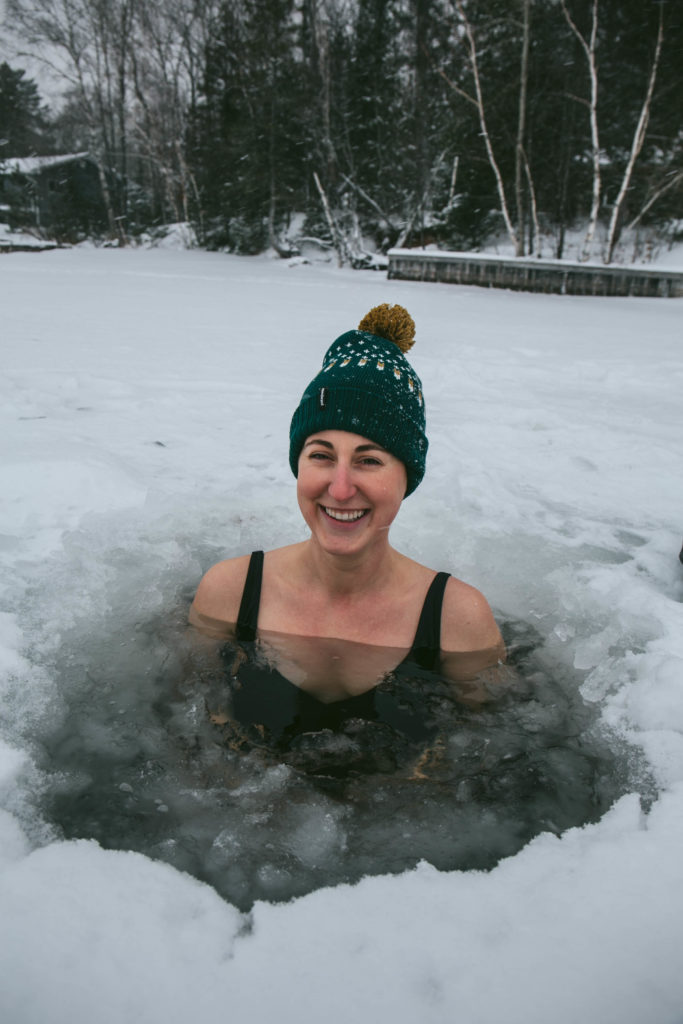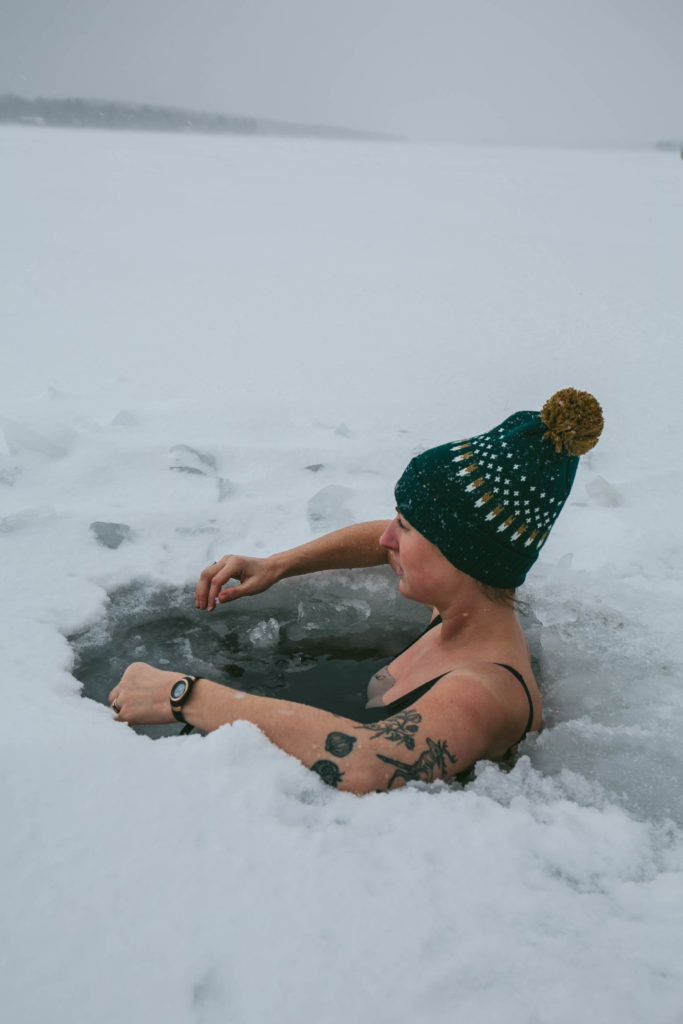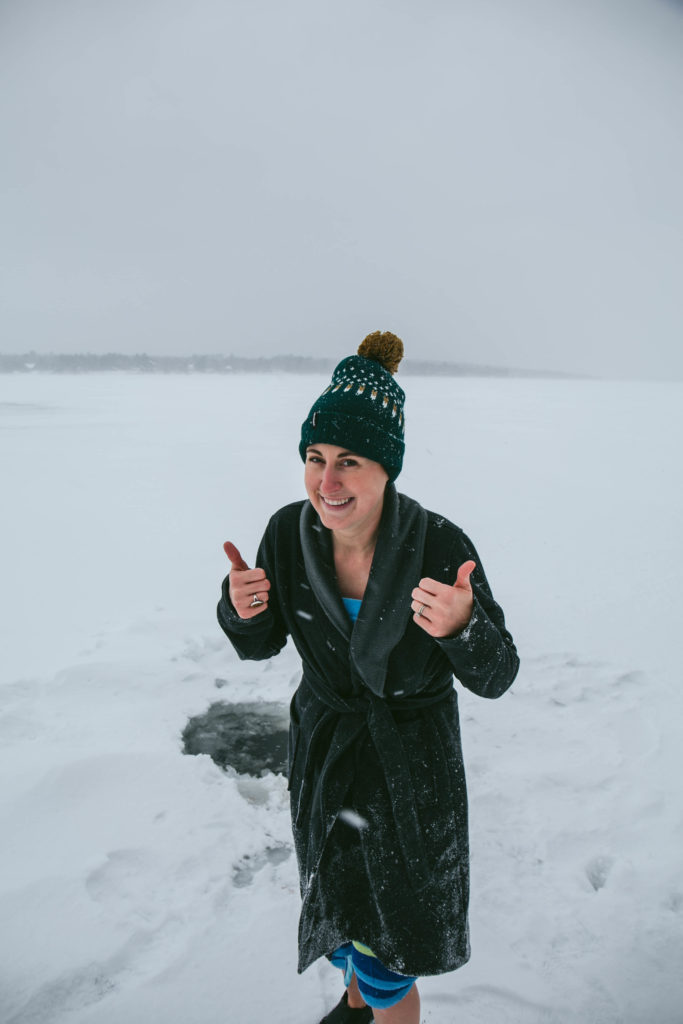Cold water swimming has become quite popular within the wellness industry as a way to decrease stress, relieve arthritis pain, increase athletic performance, and so much more! Here is my story of swimming in Lake Michigan for over 150 days to discover the health benefits of cold water immersion for rheumatoid arthritis relief.

Jump to:
In March of 2020, right when the pandemic started, my husband suddenly had some more time at home, and all work travel stopped. He took the opportunity to be home, downloaded Wim Hof's book, and started his course. He started taking cold showers and eventually worked up to taking cold dips in a lake near our house. Soon, his older sister joined him, and they hadn't stopped swimming since. I remember them taking a 10-minute cold water dip at our cottage in April while ice chunks floated around them. I thought they were crazy (and badass!).
By the time they started cold water swimming, I was nearly a year into my rheumatoid arthritis journey. My husband, full of energy and optimism, would encourage me to try cold water therapy for my pain and reduce inflammation. There was no way I was getting into cold water at that time. We have a family cottage in Michigan's upper peninsula near Lake Superior. I was always the last one in the water, usually standing in waist-deep water for minutes before working up the courage to go under. Even though I was born and raised on the shores of Lake Michigan and swam competitively from the age of six, swimming in cold water, even in July, was challenging for me. I didn't realize that all those years of swimming and living next to Lake Michigan were the intro to my cold water swimming.
My cold water challenge
In August 2020, I ended up getting COVID. While I was blessed with a very mild case, the week after being diagnosed, I went into one of my worst flare-ups. Nearly every joint was painful, and I was exhausted. My flare-up ended, and a few days later, I woke up in the middle of the night with hives all over my body. The hives would come and go for the next five days and then eventually spread to my face. I had an immune reaction to the virus, and my body had enough. After going on prednisone and getting my hives under control, I told myself, enough is enough. I'm going to try cold water swimming for rheumatoid arthritis relief.
My challenge started with swimming in Lake Michigan every day for 30 days. September weather is pretty dramatic in northern Michigan. Within four weeks, we go from sunny, warm days in the upper 70's to maple trees turning yellow and orange and a high of 50. With the weather change, the water temperature would also change, which would allow my body to acclimate to cooler water slowly.
The water temperature started around 61, and by the end of September, it lowered to about 58 degrees. I stayed in the water for 5-10 minutes depending on the waves, if my family was with me, rain, and so on. Even though that's pretty warm water, it was still a challenge for me. Remember, I was not a fan of cold water.
As September came to an end, I still enjoyed the challenge. The water temperature was not changing drastically, so I decided to stick out for another month and swim every day in October. Towards the end of October, the water was starting to drop. The water temperature went from around 58 to 51 over those four weeks. October is always a bit windy for us in northern Michigan, and with the north winds, that brings in cooler water. My four weeks ended, and I decided to continue for another eight weeks or until the end of the year. I figured I came this far; what were another two months?
November came around, and as expected, it was the coldest of my three months. I remember November 2nd was my coldest swim thus far. The air temp was 36, and the water temperature was 46. Although it was hard, I tolerated it well. I focused on my breathing. I glanced over the bay and watched the snowfall over Power Island, thinking, "Wow, that was cold, and it's going to keep getting colder." I finished up November with water temperatures around 41 degrees.
Now December had to have been my most exciting month. The month started with water temperatures in the low 40's and ended in the mid to low 30's. I also finished my year swimming in Lake Superior, the coldest soak I have had to date. 33-degree water with a thin layer of ice and air temperature of 4 degrees with wind chills of -8.
I soon realized it wasn't the water that made my cold water dips so tricky; it was getting out of the water. My husband also hacked a hole in the ice at our cottage, so I didn't have to walk out in the freezing air again. Instead, I could walk down to the water, make my way out to the ice and submerge my body in the cold water all at once. And believe it or not, it's easier to submerge your body all at once, even if the lake is frozen, compared to walking out into a lake trying to reach deeper water to submerge yourself in.
January has been similar to December. The water temperature has not changed much, and the air is still bitter cold. The only changes have been accessing open water. My once sandy beach is now covered in ice, with large ice chunks and slush banging against the icy shoreline. Making sure I get into the water safely has been my main priority while suffering some cuts and bruises. I did end up buying a portable tub to place in my backyard if the lake freezes over. For now, I am enjoying the challenge of getting into the open water of Lake Michigan.

My cold water swimming routine
By talking to other old water swimmers, I have found everyone has their water routine. For me, the moment I step on the beach, even before I enter the water, I start breathing. I take large, deep nostril breaths and focus on inhaling and exhaling. As I walk out into the water, I fully feel the pins and needles and the goosebumps on my skin. My heart starts to beat faster, feeling the stress of the cold water, but my brain is telling me it's temporary and you will be warm again soon enough.
I usually wait a few seconds to allow my lower body to acclimate and then submerge my body to my shoulders. Once my chest is under, I feel a quick flutter in my heart and butterflies in my stomach. It's a natural reaction to the cold water, but it goes away with the first breath. Next, I focus on being present with the water, making sure I breathe deep. Within a minute, my body has adapted. During this time, I do three things:
- I pray-I say thank you to God for the fresh clean water I have access to, for giving me this tool to help my body heal and to feel strong. I ask for strength to stay in the water and clarity to know when it’s time to get out.
- Next, I give thanks to the water. I say thank you for holding me and being with me during my swim. I give thanks for its healing energy and tell it I will see it again tomorrow.
- Lastly, I visualize my body healed. I visualize sitting in cold water and white and blue water flowing into my body and swirling around each of my joints removing anything red or black and taking it out into the water leaving restored and light joints. Lastly, I blow a kiss or kiss my hand and lay it on the water.
After my gratitude practice, I go for a swim. While some like to sit and soak, I want to move. I will swim out towards the deep water for 20-30 breaststrokes, turn around and do 25-30 back. If I feel like it, I do it again. By this time, I've been soaking for about 3 minutes. If I feel like I have a bit more in me, I'll go for another 10-20 breaststrokes. Every minute or so, I check in with my body to feel OK to sit for a bit longer. It's important to distinguish between ego and challenge yourself a little more. I'm starting to walk out of the water by this time, and I feel invigorated and energized. My skin is red, and I have goosebumps. I feel so proud that I decided to challenge myself to heal my body further.
Benefits of cold water swimming
Wim Hof goes into the details around some of the potential health benefits on his website and in his e-book. Some include:
- More energy
- Boosting the immune system
- Arthritis relief
- Better sleep
- Workout recovery
- Asthma management
- Increase athletic performance
- Boost energy
- Increase metabolism
- Relive stress
- Improve cold toleerance
- Deal with depression
- and more!
The benefits I have noticed so far
Decrease in inflammation
While it may seem counterintuitive to expose stiff, immobile, and tender joints to the cold, which leads to even more stiffness and immobility for a short period, what I have found is that brief exposure to very cold temperatures increases my mobility, decreases stiffness, and tenderness. This is due to the decrease in inflammation in my joints experienced when submerged in the cold water. Once warmed up, usually about 10-15 minutes later, they move more freely than before my swims.
I didn't see a significant decrease in inflammation when I started swimming. Still, as the water temperature dropped, especially in December, the benefits increased, and I saw a reduction in swelling. I found that the cooler water, below 45 degrees, was where my body started to respond to the water.
Body temperature regulation
A common symptom of Hashimoto's thyroiditis, an autoimmune condition of the thyroid, is low body temperature regulation, usually leading individuals to being cold and having a feeling of never being able to warm up. Before cold water swimming, I would have to wear a sweater in the house along with socks and slippers three seasons of the year to stay warm. While I still wear a sweater and socks, my feet and hands are not as cold as they used to be. I am also perfectly fine not wearing a sweater if I don't need to. I have experienced the benefit of more body temperature regulation which, in return, I do not get as cold as fast and for very long.
Changes in my mood and attitude
By far, one of the most significant benefits I have experienced from cold water swimming for rheumatoid arthritis relief is the change in my mood and attitude. When I get out of the water, I feel invigorated and energized. The rush of endorphins is enough to make me feel like I'm on top of the world.
Because I am intentionally putting myself in a very stressful situation, I now handle other stressful events more easily. Don't get me wrong, I still get frustrated or anxious, but my reaction to these situations is not as extreme as it would be in the past.
One example is getting into cold water. When I first started, I would get so worked up, and my anxiety was almost too much for me to handle. Now, even though there is still some anxiety accompanying the anticipation of getting into the water, I can go right from the beach to the water without hesitation. I also found I am a much more calm mother. The little things my kids do don't throw off my day. And yes, some things my kids did, like drawing on the walls, throwing their food, biting each other, etc... would ruin my day, and I would have a hard time snapping out of it. Now, I understand it's temporary, and they are doing exactly what they are supposed to be doing, being kids!
My plans for the future
We are already towards the end of January, and I have continued to swim every day. Honestly, I don't see an end in sight. With air temperatures averaging 20 degrees and the water around 34 degrees, the shores of Lake Michigan are turning into ice with large ice chunks and some completely frozen areas on the beaches. Finding open water is getting harder. While I decided early on that, I would make cold water therapy a daily practice, the way I do it may change, especially as I wait for spring to arrive. Thankfully, the ice will be melting in March, but the water temperature will stay around 34 and slowly creep up into the 40's come May. While I may have to cold dip in a tub in my backyard for a few weeks, come March, I will have lots of time for wild swimming until summer.
Have you tried cold water swimming or another type of cold water therapy such as a cold shower or even a fun polar plunge with friends? How did you feel afterward? I would love to know in the comments below!
I have more blog posts coming up discussing my tips and tricks for cold water swimming for rheumatoid arthritis. I am also working on an experiment-I guess it is a new challenge! Make sure to sign up for my newsletter to be updated on when these blog posts drop!

If you are looking for more blog posts on wellness, check out why I use functional medicine to help heal my autoimmune conditions along with how I used Seed Cycling for Horomone Balance.



I find this whole journey of yours incredibly inspirational and educational. Thank you for sharing all the details of your journey. My God continue to bless you and your family.
Lisa
Thank you for your kind words, Lisa! It's been a challenge getting into that cold water day after day but I also wake up looking forward to it. 🙂
Hi Lisa
Thanks for sharing your experience
I also can suffer from Rheumatoid Arthrtis and have tried Wim Hoff breathing and cold shower method but wasn’t keen and didn’t stay with it
In April this year while visiting family on Lake Huron we were boating every day. I couldn’t resist going into the cold Water from the boat. Like you, it was a relief to my entire system, inflammation pain was washed away by the lake and I felt invigorated and delighted.
Back home now in London England a friend has passed your link to me and you be inspired me to “give it a go” and swim in the Lido outdoor pond.
Thanks again
Vickie
Love this, Vickie!!!
Thank you very inspiring. When you first started did you find you flared after cold water dips? Thanks
Hi Caroline, I did not experience flare-ups when I first started. Although this isn't uncommon due to the changes in the immune system. They should settle down with consistency.
Thank you. I have been swimming weekly since May. I feel I have returned to my roots.
I, also , have RA and 100% feel the benefits of immersion. Your article was an inspiration.
Your story is fascinating!